Over the past decade, hybrid work has proven to be an impressively beneficial business practice for companies worldwide. Even more, its adoption was sped up by the widespread lockdowns in 2020, bringing more and more organisations on board. But while there’s indisputable proof about the benefits of combining in-house and remote work, it should go without saying that the hybrid workforce deals with some pretty significant challenges as well.
For this reason, managers and business leaders must find ways to surmount those challenges—especially those that negatively impact employee wellbeing.
Fortunately, though, this is not an impossible task. It may require some revision to company culture, but putting in the work promises a better experience for everyone involved. And, it turns out that a lot can be achieved with technology.
Are you interested in taking better care of your hybrid workforce? Do you want to find ways to utilise tech for this purpose? If that’s the case, read on to learn about investing in software and hardware solutions that promote hybrid workforce wellbeing.
Why You Need to Pay Attention to Hybrid Workforce Wellbeing
Before you start investing in software and hardware that’s supposed to keep your employees healthy and happy, you must understand the exact challenges that hybrid work poses for digital professionals.
A place to start would be to conduct a survey amongst your own employees. If that’s not possible, you can look at the data currently available to all.
According to McKinsey, the fears employees have regarding remote work after the pandemic include:
- Worse work-life balance
- Loss of community and communication gaps
- Reduced collaboration between teams
- Decreased focus on employee wellbeing
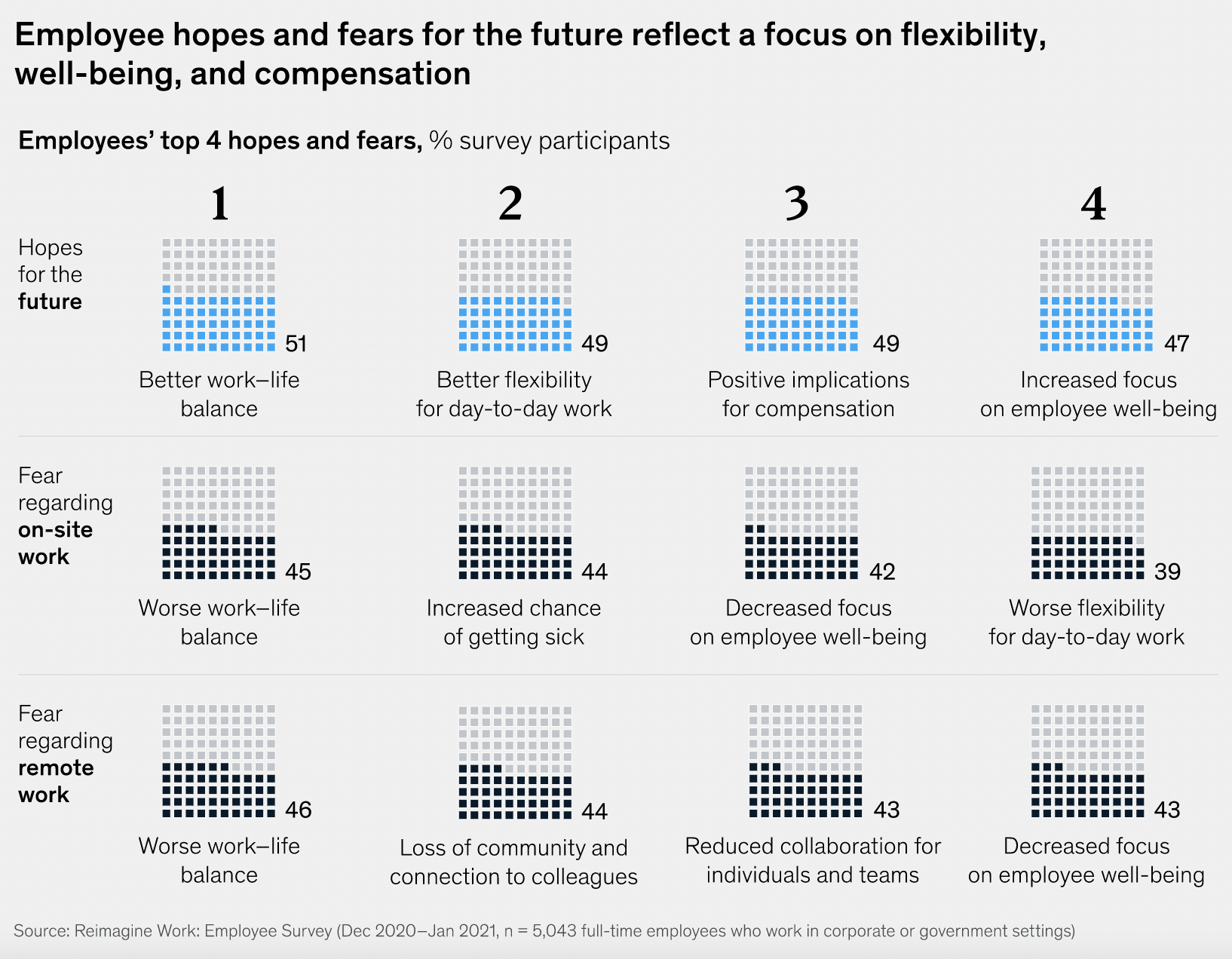
Source: mckinsey.com
So, if you know that people feel uneasy about working remotely full-time, but also understand the challenges of going back to the office, hybrid work seems like the perfect solution. That is until you consider the fact that, despite offering multiple benefits, it also comes with some serious challenges.
To solve this problem, you can use tech—either software or hardware. The right solutions won’t just help with employee health. They’ll also contribute to their happiness and productivity, eventually benefiting your entire organisation.
But how do you get started with implementing wellbeing-oriented tech in your business? Do you focus exclusively on health-oriented apps and gadgets? Or do you keep an open mind and look at all the potential ways tech can help you keep your hybrid workforce in top performance condition?
Whichever you choose, you’re on the right path. But, the following are our tips for using technology to take care of your hybrid workforce.
1. Use Better Hardware
According to several surveys, the leading cause of work-related stress tends to be an unmanageable workload. And, obviously, eliminating that type of stressor isn’t entirely possible without expanding workforces, scaling growth, and changing management styles. However, technology can make workloads more manageable.
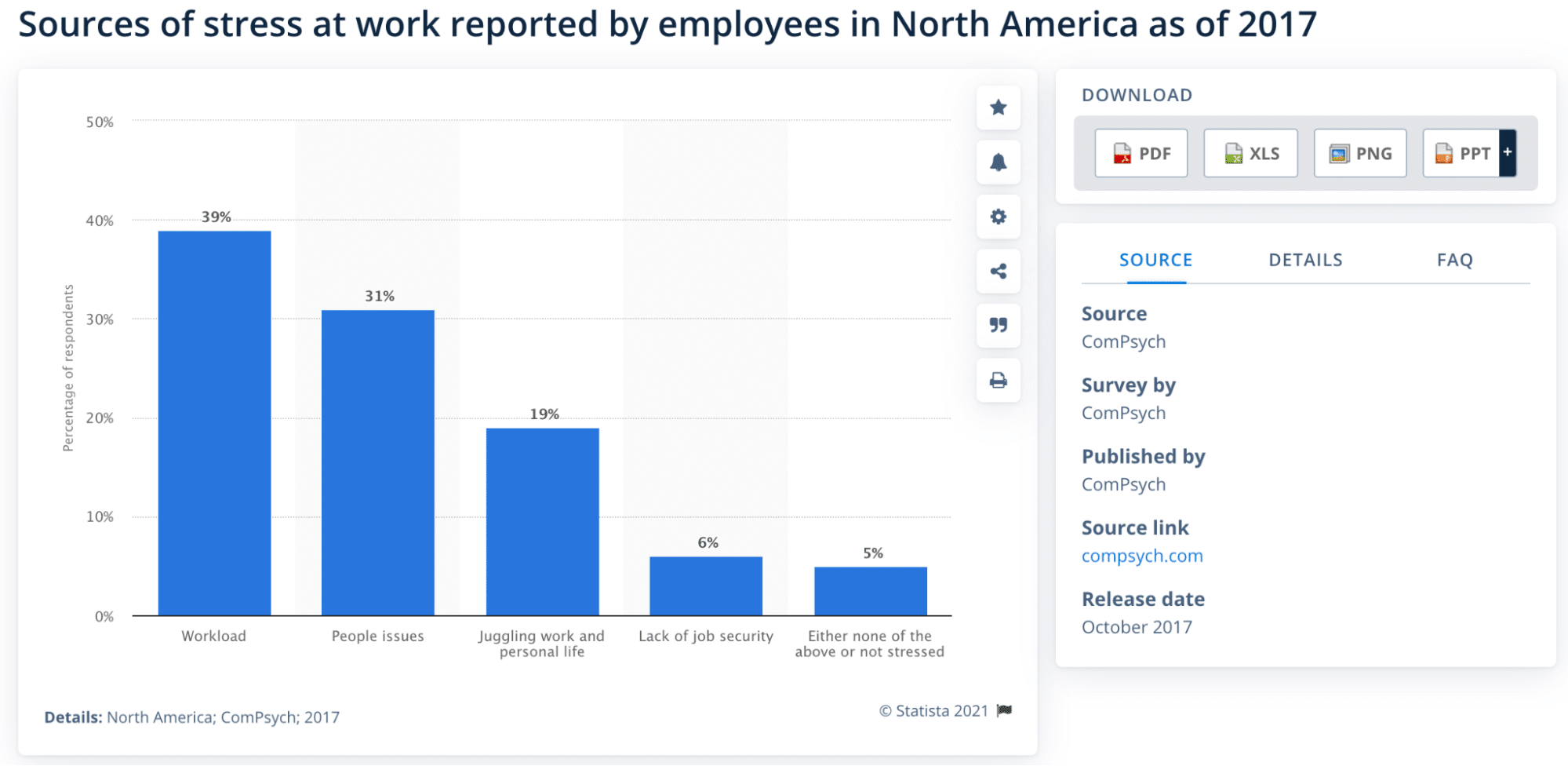
Source: statista.com
For one, simply investing in better hardware could help speed up everyday work processes. This is especially true in creative industries that require high-power computers to finalise tasks. Secondly, by using existing technology in new ways, employers can turn existing systems into sources of enjoyment and work motivation.
A great example comes from a 2017 study. A group of researchers took already-available tech—smartphones and the internet—and used them to add a gamification element to several computer numerical control machine-operational jobs.
The results clearly indicated that the right way of using technology didn’t just improve employee performance. It also positively influenced job motivation and job satisfaction. Both of these could potentially mitigate the consequences of working in a high-demand workplace.
2. Use Automation
Another super-effective way to take care of your hybrid workforce is to utilise automation software. The most pronounced application is automating workflows to reduce employees’ workloads. But, there are other ways automation can contribute to employee wellbeing.
Mitigate risk for high-value tasks
You can exponentially minimise the chances of human error by setting up a piece of software to:
- Do complicated calculations
- Manage inventory
- Send out information at the right time
More importantly, you can relieve pressure from your employees by using automation to provide a safety net. This safety net allows them to direct their focus towards the things only they can perform. They’ll work and feel much better once they don’t have to worry about spreadsheets and tedious menial tasks.
Free up time for high-value work
For example, by using an automated time-tracker, your hybrid workforce won’t have to worry about punching in or counting work hours. Instead, they will be able to fully dedicate themselves to their tasks.
Or, by using technology to monitor employee performance, you’re equipping your management to give better, personalised feedback that will inevitably empower your workforce to become even better at what they do.
Prevent employee burnout
Finally, you can even use automation to help you encourage sufficient rest and time off. Consequently, it will contribute to minimising and even preventing employee burnout.
By creating an Excel vacation schedule or using a dedicated leave management tool, you can allow employees to request time off without any unnecessary obstacles. Just set up an HR approval system to ensure a hitchless experience.
Of course, these are not the only ways tech can make the work experience more enjoyable for your employees. For example, you can create an optimal environment for enjoyment and productivity by tweaking your workspace setup.
Enable automated systems for lighting and air-quality management. Furthermore, enriching the workspace with experience-boosting gadgets (like automated coffee makers or diffusers) can also help.
If you’re fully committed to making your employees’ work experience 100% oriented towards their health and happiness, these are all viable options for you to consider.
3. Create Tech-Aided Systems That Prevent Communication Gaps
While we’re on the subject of ideal work environments, there’s one essential fact we have to address. And that is: Communication plays a significant role in ensuring company wellbeing.
As one of the leading causes of hybrid workforce frustrations, organisational leaders need to find ways to bridge communication gaps. Doing so won’t just increase transparency (and remove the related stress or insecurities your workforce may feel). But, it will also help your team do a better job as they’ll have better insights into what’s expected of them and why their work matters.
By organising your internal company communication around transparency—focusing on honesty, the free flow of information, and active involvement in keeping everyone up to date—you can avoid a whole lot of misunderstandings, wasted hours, and potential employee dissatisfaction.
The obvious way technology can help you accomplish this is by providing software solutions for hybrid team communication. Whether you use video conferencing software or plain old email, your number one priority should be transparency.
But, in addition to harnessing the power of technology for this purpose, you’ll also have to make changes to the way you communicate. That means:
- Err on the side of overcommunication.
- Use meeting notes and summaries.
- Invest in text-to-speech software to make it easier for management to keep in touch with their team members.
Another thing that can help your employees thrive regardless of their physical location? Look at the ways information is shared within your organisation.
- Try to identify possible silos.
- Look at ways to automate data sharing and management.
- Double-check whether everyone has access to the right resources.
It’s a relatively small consideration, but it can be a significant contributor to eliminating unnecessary time losses and, even worse, sources of work-related stress.
4. Enforce Boundaries With Tech
Another great way to apply technology in your hybrid workforce’s wellbeing is to use it in a way that enforces boundaries.
Are your employees distributed globally and working in different time zones? Maybe they’re taking advantage of a flexible work hours policy? If any of these are true, you must ensure that their private time isn’t jeopardised by work-related communications. Fortunately, you can easily use technology to make this easier.
Simple functions like “Do Not Disturb,” notification schedule functions, or even taking the time to schedule emails instead of sending them at 2 A.M. on a Saturday can go a long way in helping your hybrid workforce take control of their work-life balance.
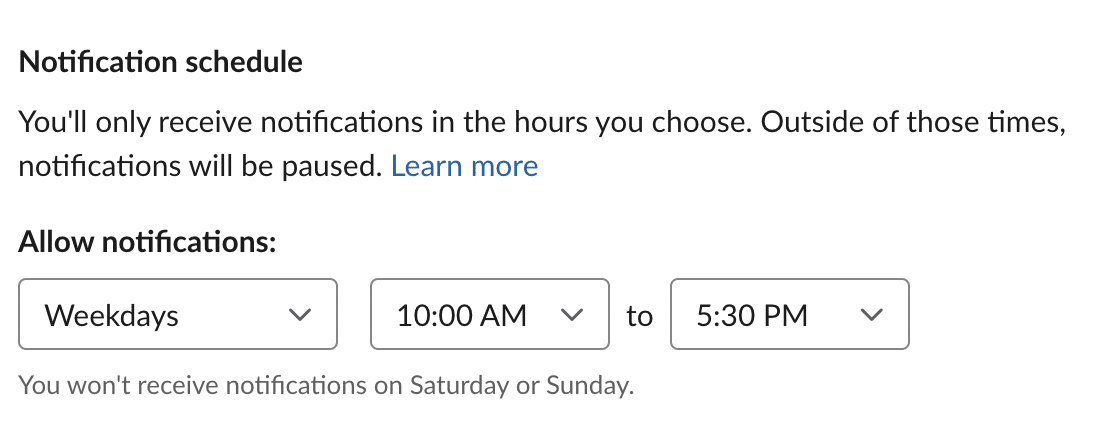
Source: slack.com
Another super-effective way to use tech to enhance employee wellbeing will be coming in the form of Apple’s upcoming iOS15 software update.
A feature called “Focus Mode” will allow users to filter notifications and apps based on the activities they’re doing. So, by automating “Focus Mode” to come on during work hours, your workers will be able to commit their full attention to their work. Then, once they’re done, they can set their focus on something else, like relaxation, and not have to worry about getting work-related emails or instant messages that would prevent them from winding down.
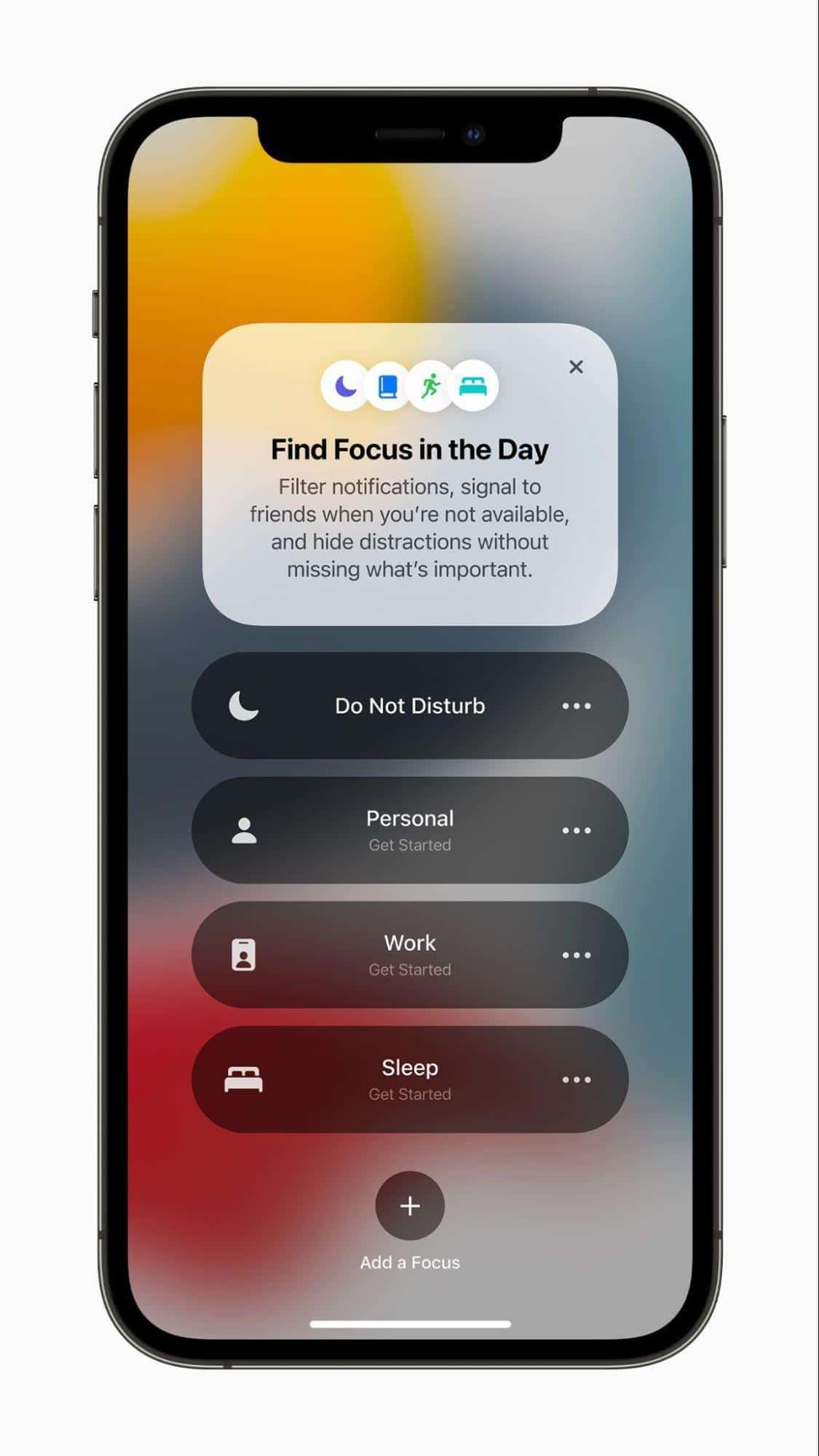
Source: apple.com
5. Experiment With Health Tech
Now, if your idea of taking care of your hybrid workforce with tech encompasses literally taking care of their physical and emotional wellbeing, you’re in luck. Over the past decade, technological leaps have allowed us to track, analyse, and improve almost all aspects of our wellbeing with smart devices.
Wearables like smartwatches, sleep-tracking rings, and posture trainers are all great investments for those looking to improve their health. But, given their prices and somewhat intrusive nature, you can also choose different methods to use technology to take care of your hybrid workforce.
For example, you can enrich your benefits package with paid services and products like:
- Online therapy
- Mental health app subscriptions
- Digital fitness programs that will encourage employees to take better care of themselves
- A great mattress that will help improve sleep and aid in rest and relaxation
The results will inevitably include better overall wellbeing. And they won’t just benefit your workers but your company as well, considering that healthy employees make productive employees.
6. Surmount Physical Distances With Virtual Events
If, after all of these suggestions, you still feel like you’re not doing enough to support and take care of your hybrid workforce, it may be time to come up with ways that will overcome the challenges of running a distributed team.
One such way is to include virtual events in your company’s activities.
Online events allow you to enrich everyday communication with visual and auditory cues. They can play a role in helping you nurture stronger bonds and encourage collaboration within your team.
These events can be anything from online game nights to educational get-togethers. The former will serve as team-building events while the latter can help equip your organisation with new skills.
The point is to try and make them as useful as possible. Furthermore, you will inevitably achieve better results if you make these events fun. Add an element of gamification or a company swag box you send to remote employees to make them feel like part of the team.
7. Invest in Cybersecurity
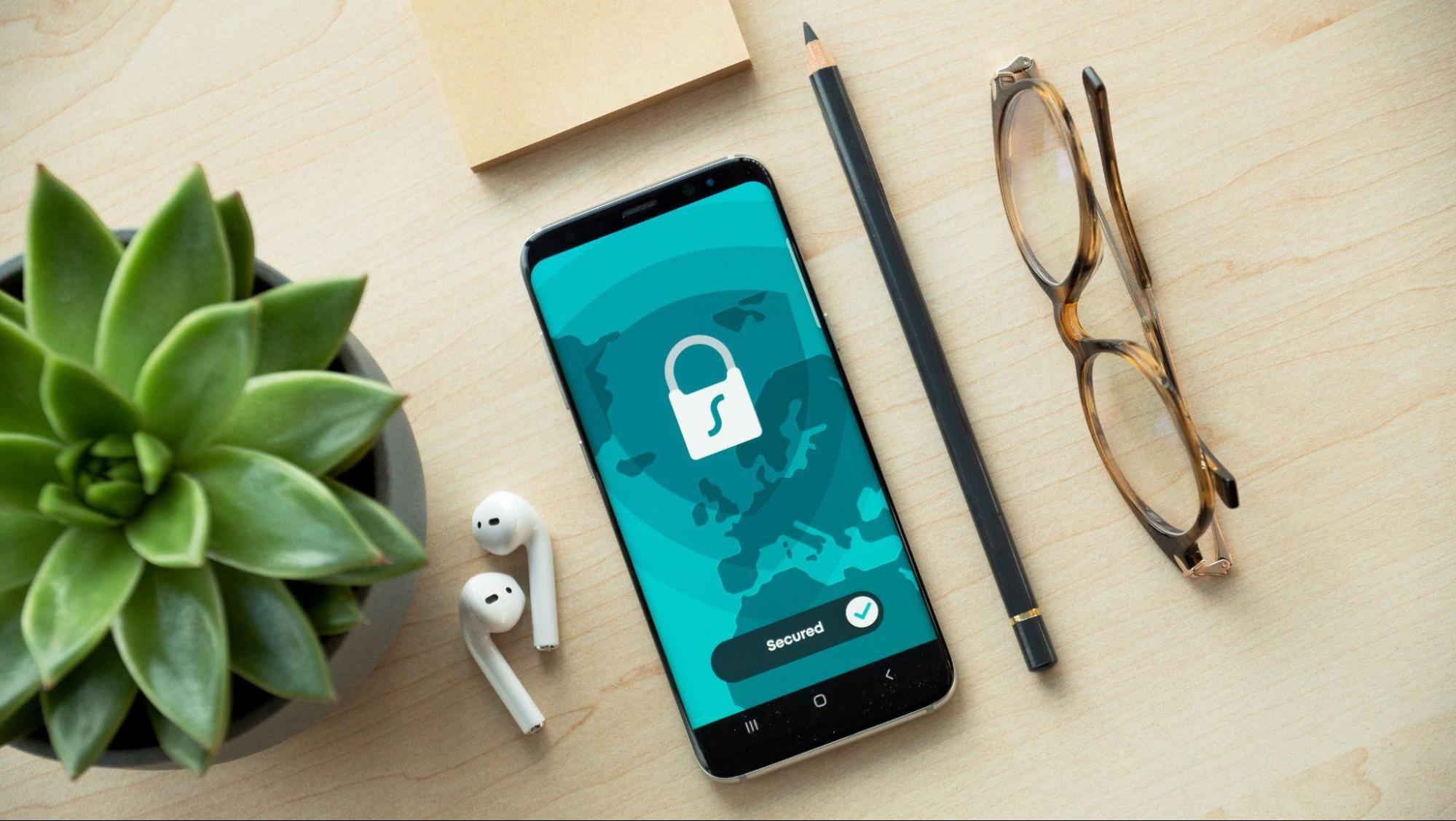
Source: unsplash.com
Last but not least, when looking for ways to use tech to benefit your hybrid workforce, you need to make sure that you don’t forget about cybersecurity.
Unfortunately, work done away from the office (and its more easily secured networks) comes with a variety of threats that can jeopardise your employees, their work, and your company’s intellectual property. Fortunately, many of these threats are preventable.
One of the easiest ways to do this is to implement tech solutions like VPNs and password managers. These won’t just protect your brand and workforce but will also prevent cybersecurity from becoming a nuisance.
Moreover, take precautionary measures that will protect your organisation from malicious attacks and possible accidents. Habits as simple as performing regular website backups and being diligent about software updates protect everyone involved and prevent a great deal of stress.
Final Thoughts
Sure, switching to a hybrid work model may require some adjustments. However, that should definitely not be an excuse for taking poor care of your distributed workforce. After all, the likelihood of the world going back to exclusively in-office work is looking slim. Teams will need to adopt an agile approach to keeping up with current trends.
Fortunately enough, technology can do a lot to help you keep your employees healthy, happy, engaged, and empowered—even if they’re scattered around the world. And, as science progresses, apps and tech will be capable of doing even more.
With that in mind, it’s high time for you to look at possible ways to bring software and hardware solutions onboard to take better care of your team.
Of course, don’t forget that positive change always requires a solid foundation. So, if boosting morale or ensuring that everyone is in top shape are your priorities, check whether your company culture is oriented towards employee wellbeing. See whether it still needs some work to get where you want it to be.
Originally published Sep 13, 2021, updated Jan 16, 2023
